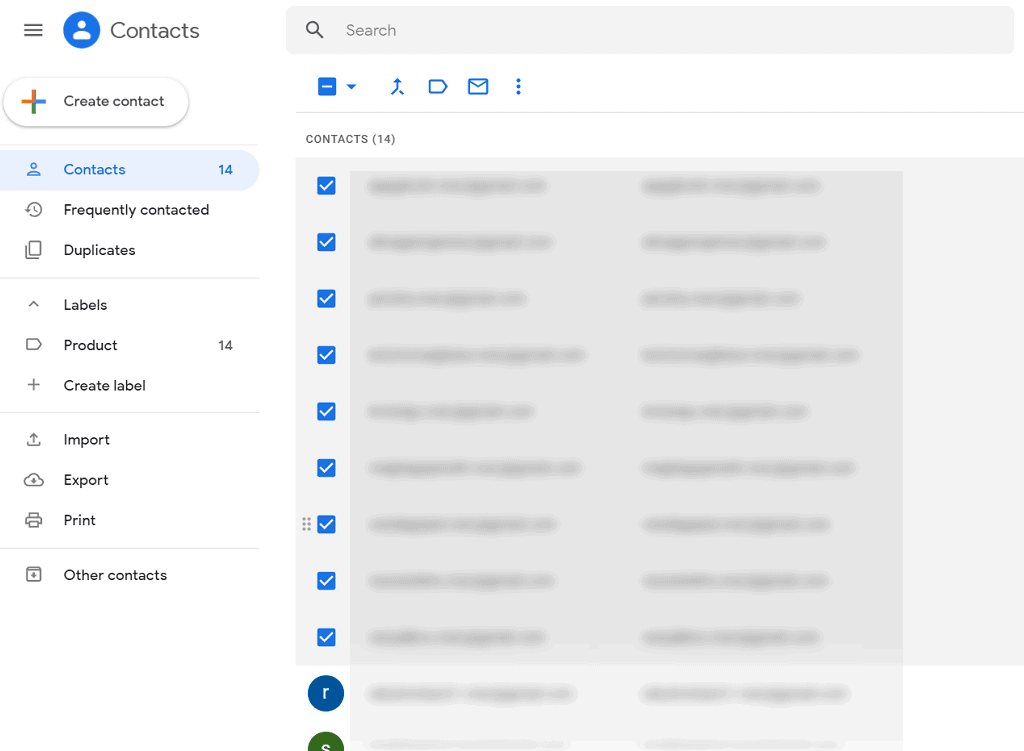Top Strategies On Selecting An Email List Website
Top Strategies On Selecting An Email List Website
Blog Article
What Should I Be Thinking About When Purchasing The Family Medicine Email Database?
To reap the maximum benefits from your outreach and marketing campaign, you must take into consideration several crucial aspects. Here are some points to consider: Accuracy of data and quality
Source of Data: Ensure that the provider collects data from trusted and authentic sources for example, medical directories professional associations, licensing boards and opt-in databases. Family medicine practitioners’ email addresses should be up-to-date and relevant to the audience you are targeting.
Verification Process: Ask about the verification procedure used by your service provider. Inactive or incorrect emails should be removed, and the list of emails should be updated regularly. Validated email addresses reduce bounce rates and enhance the speed of delivery.
Segmentation options Include segmentation options based upon factors like geography (country or state) as well as the level of experience, practice size and specific interests (e.g. pediatrics, geriatrics or preventive medicine). Segmentation can help with more personal and specific outreach, which increases engagement rates.
2. Compliance with Legal Regulations
Data Privacy Laws: Ensure the list conforms to General Data Protection Regulation (GDPR) in Europe, California Consumer Privacy Act (CCPA) in the U.S., and other relevant laws regarding data privacy. Email addresses should only be gathered only with the consent of the user and legally to stay clear of legal penalties.
CANSPAM Act Compliance If you are involved in email marketing within the U.S.A. be sure your list complies with the CANSPAM Act. This includes providing clear opt-out mechanisms and not using deceptive subject lines or false details within your emails.
Opt-In Consent : Confirm that the email addresses that were collected obtained through consent. This means that family medicine physicians were willing to receive marketing messages from third-parties, ensuring the compliance of patients and reducing complaints about spam.
3. Provider Reputation
A reputable provider: Choose a service provider who is known for providing top-quality and compliant data. Find customer reviews, testimonials as well as case studies, to make sure the provider is trustworthy and reliable.
Transparency: Providers must be transparent about how they collect data and how often it's updated. It is a red-flag if the data provider is unable to describe their methods of sourcing.
Customer Support: Ensure that the provider offers a robust customer support. It is possible that you need help with technical matters or list segmentation, and/or making sure your list conforms to.
4. Cost and Return on investment (ROI).
Pricing Models. The providers offer different pricing models, like pay per contact, flat fee or subscription. Select a pricing model that suits your budget and provides an investment that will yield a profit.
Refund and Replacement Policy Trustworthy service providers provide an option to replace or refund for invalid or outdated email addresses. Make sure you understand the terms of the policy prior to purchasing in order to protect your purchase.
Don't focus on price alone. Although a cheaper list might look appealing, it could result in poor delivery or an excessive bounce rate. A top-quality list will offer better quality targeting, more engagement and a higher return on investment.
5. Ownership, use, and ownership
Single Use as well as Multiple Use Multiple Use: Clarify whether you can utilize the list in multiple instances or if it's for single-use only. Lists that can be used in multiple campaigns are more valuable. This is particularly true if you're planning on doing regular outreach.
Exclusive vs. shared lists - Identify if your list is exclusive or shared with several buyers. Exclusive lists are less likely to create crowds that are too saturated and usually will result in better engagement rates.
6. Data Integration and Format
CRM Compatibility: Make sure that the list of email addresses you're making use of is compatible with your Customer Relations Management (CRM) tool or marketing email system (e.g. CSV or Excel). This ensures smooth integration and user-friendly.
Ease of Use: Ensure that the list is well-organized and simple to sort or segment according to the factors that are important to your campaign. This will simplify your messaging and targeting efforts.
7. Ethical Questions
Relevance of Outreach physicians are often busy, which is why it's important to tailor your outreach to their profession. Avoid sending generic or irrelevant messages, as they could affect your brand's image and lead to low engagement or spam complaint.
Beware of Spam practices. Send emails with care. Do not over-email. Sending numerous emails or insignificant promotions can result in unsubscribes, spam complaints, or even a negative reputation for the sender.
Click here to view the entire article. Click here to view the full
When buying the Family Medicine email list, be sure to consider data quality, legal compliance, and reputation of the company to ensure your outreach efforts are effective. Look for data that has been filtered and verified to be compliant with privacy rules and also in line with your audience. By investing in lists of high-quality and sending relevant messages, you can increase engagement and also increase your marketing ROI. View the most popular family medicine email list for blog recommendations.
What Factors Should I Be Thinking About When Buying An Urgent Care Email List?
It is important to take into consideration a variety of aspects when buying an email list to provide urgent treatment. This will help ensure that the list you purchase is accurate and compliant with the law and relevant to marketing goals. Here are key considerations. Quality of data and accuracy
Source of data: Make sure that the service provider has sourced their data from reliable sources such as medical associations or databases for healthcare. Avoid lists created by scraping data or other unreliable methods as they could contain incorrect and outdated information.
Verification: Make sure that the email list is regularly up-to-date. A reliable provider follows strict verification procedures to eliminate invalid, old, and duplicate email addresses. This guarantees high delivery and decreases bounce rate.
Segmentation of Lists: The lists can be classified according to the following elements: location (city/state/region), the size (e.g. urgent care facilities aren't huge), specialties provided (e.g. pediatrics and diagnostics), as well as the role taken on by decision-makers. Lists that are targeted improve your outreach and increase engagement.
2. Legal Regulations
Data Privacy Laws - Ensure the list complies to relevant privacy laws for data like the General Data Protection Regulation in Europe and the California Consumer Privacy Act in the U.S.A. It is a requirement that emails collected must be done with the proper consent and processed in a legal manner.
CAN SPAM Act: In the U.S.A. all emails that are sent out to market are subject to the CAN SPAM Act. Incorporate the physical address of your company, stay clear of false subject lines, and offer an easy opt-out mechanism. Infractions could lead to penalties and harm to your brand's image.
Opt-in Consent: Ensure that all email addresses in the list were acquired with explicit permission. This means that recipients have explicitly agreed to receive marketing communications. This will reduce the possibility of complaints about spam and legal issues.
3. Provider Reputation
Established Providers: Select one with an established track record of providing compliant and high-quality lists. To determine the credibility of a provider and their customer satisfaction, check reviews, testimonials, and case studies.
Transparency - The provider must be open about the data's source and the date it was last updated. If the service provider is unable to provide clear answers about the methods used to collect data It could be a sign of poor quality data.
Customer Support: A strong support for customers is essential if you need assistance in relation to technical issues, list customization, or compliance. A responsive service provider will help you get the most benefit from your email list.
4. Return on investment (ROI) and cost
Pricing Models: Email list providers generally have different pricing models including pay-per-contact and flat charges. Think about the pricing structure in relation to your budget for marketing and expected ROI. Take into consideration the cost and the quality of your list.
Refund or Replacement Policy: Trustworthy service providers usually offer an option to return or replace the item in the event that a substantial part of the addresses are inaccessible or invalid. Be sure to review the specifics of this policy prior to buying.
Value for money: Instead of choosing the cheapest option look for lists that offer value through accurate information and precise segmentation. A database that is of high quality will increase the engagement of users and improve return on investment.
5. Data Usage and ownership
Make use of the list only once or more than once. Lists that can be used for multiple purposes are recommended, especially if you want to run outreach campaigns frequently.
Exclusive vs. Shared lists: Determine the list's exclusivity or shared. Shared Lists may cause list fatigue because recipients will receive several marketing messages.
6. Integration and Data Format
CRM Compatibility. Make sure your email lists are delivered in formats compatible with the platform you're using for email marketing or customer relationship management, such CSV or Excel. This will ensure a seamless integration, and allows you to begin your campaigns swiftly.
Ease in Use The email lists should be manageable and easily segmented according to specific parameters. A well-organized list can make targeting and personalization more effective.
7. Ethical considerations
Relevance of Content Health professionals working in urgent care are often busy, so your communication should be timely and beneficial. Create your own messages that meet the specific needs of their clients like the medical supplies, equipment or healthcare technology they need. Inadequate content can harm your reputation as a brand and reduce engagement.
Be aware of the frequency with which you email. Overly frequent or repetitive emails can result in spam complaints and lower the reputation of your sender.
Conclusion
Focus on the quality of data as well as legal compliance and reputation when purchasing an urgent care email list. Be sure that the list is divided. The data must be kept up-to-date and must meet the privacy laws. By sending targeted information and investing in a reliable and high-quality mailing list you will increase the number of people who respond and earn a decent ROI for your investment. Check out the top rated urgent care email list for blog recommendations.